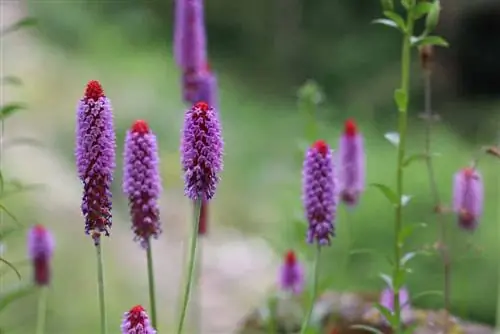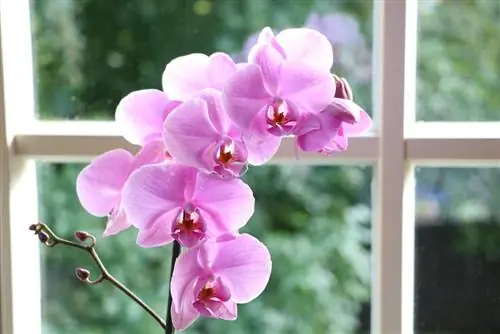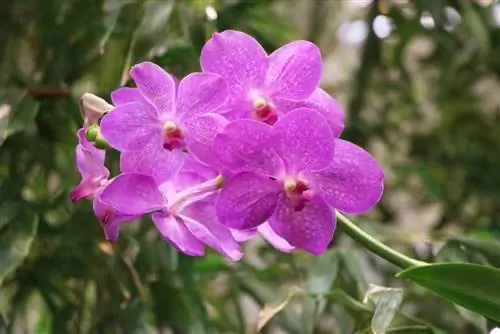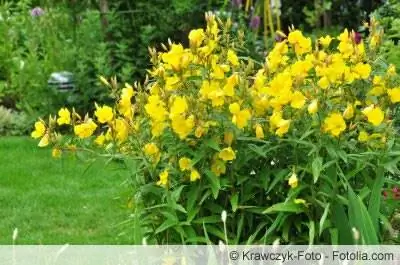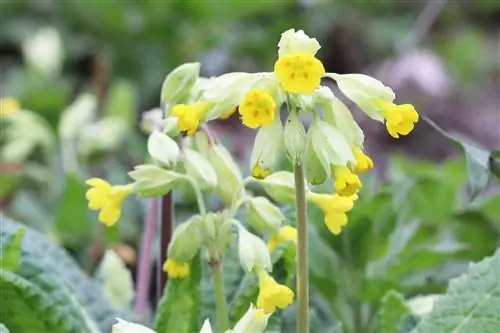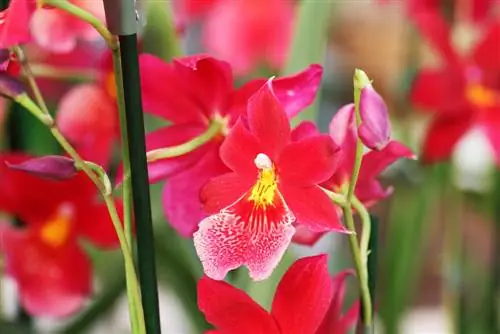- Author admin [email protected].
- Public 2023-12-17 03:39.
- Last modified 2025-01-24 12:45.
If you want a gracefully flowering and easy-care plant in your garden, you should choose the orchid primrose.
Profile
- Species/Family: Perennial. Belongs to the primrose family (Primulaceae)
- Flowering time: June to August with pyramid-shaped flower candles, which are untypical for primroses, consisting of many small red buds and pink to light purple flowers. Blooms from below
- Foliage: Elongated, rounded leaves in light green with clear grain, slightly curled downwards towards the edge.
- Growth: Upright bushy
- Height: 30cm without, 40 to 50cm with flower
- Location: Partially shaded to shady, but not too dark. Also tolerates a sunny location if the soil is not heated too much. Preferably at the edge of the pond. Cool, moist, permeable, low-lime and humus-rich soil
- Planting time: Any time as long as the ground is not frozen
- Cut: Spring close to the ground
- Partner: Beautiful in tuffs of 3-5 plants
- Propagation: collecting seeds (see propagation by collecting seeds below)
- Wintering: Hardy
The purple-flowering orchid primrose originally comes from China and is not, as might be assumed, an orchid but a primrose. This perennial can therefore also be easily cultivated in the home garden, as it occurs primarily in moist or higher areas. Primula vialii delights the hobby gardener from May to July.
Primroses are still considered old-fashioned and boring. When primroses are mentioned, people often think of grandma's windowsill. But the easy-care, perennial perennials are better than their reputation and are particularly suitable for wetter areas. The orchid primrose in particular, which, as the name suggests, is reminiscent of graceful orchids with its flowers, delights the viewer in home gardens from May to July with rich, dark red to violet flowers. So the Primula vialii shouldn't be missing from any garden bed.
Plants
The ideal planting time for the orchid primrose is spring, but as a perennial, Primula vialii can also be planted in summer and into late autumn. It is good if the perennial is purchased online or in a garden store, as it will bloom in the first year of planting. But you can also plant your own grown plants in the ground at any time, except on frosty days. Home-grown perennials often only bloom in the second year after planting. For visual appeal, several perennials should always be planted together. If the Primula vialii are planted in a circle of around three to five plants, it looks more graceful, but of course the perennials can also be planted in two or three rows in a row in the garden bed. You should ensure a distance of around 50 cm between the individual plants. Otherwise, the following must be noted here:
- Soil must not be frozen on planting day
- The perennials look beautiful when planted in a group of about three to five plants
- to do this, dig holes appropriately large for the roots
- mix the removed soil with compost
- Water the roots of the orchid primrose well before planting
- Insert and add the prepared soil again and press down well
- water again and don't let the soil dry out in the near future
Tip:
Since the orchid primroses do not tolerate waterlogging despite their large water requirement, when planting, whether in a bed or in a pot, drainage made of potsherds, stones or gravel should be created before the plants are placed in the ground.
Location
A moist location without waterlogging is ideal for the orchid primrose, because in its native China it is often found near bodies of water or in very humid areas. A spot in the shade or partial shade is ideal. However, it shouldn't be too dark either, as in very dark places the flowering will be less or even non-existent. However, it can usually only tolerate the blazing sun if it is provided with enough water. If there is a rock garden or a small pond in the garden, these are the optimal locations for the Primula vialii. Of course, the ground-hugging perennial with the longer flower stalk can also be cultivated in a bucket or balcony box.
Substrate & Soil
Orchid primroses prefer a low-lime, humus-rich and permeable soil. Before planting for the first time, the soil should be prepared with sand or gravel and a portion of compost.
Watering & Fertilizing
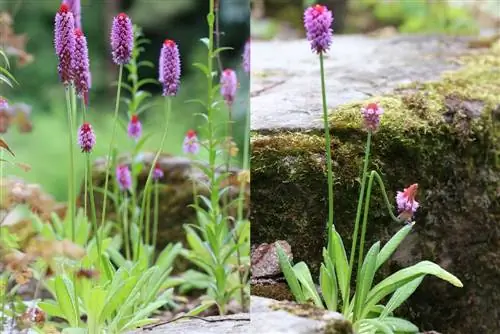
The orchid primrose does not require much care. In the spring before budding, it should be supplied with compost or slow-release fertilizer from the market. However, the perennial prefers moist soil and must therefore be protected from drying out. Therefore, the main thing to note here is:
- Never allow the soil to dry out
- the orchid primrose does not forgive even a short dry phase and, in the worst case, dies
- therefore water regularly, but avoid waterlogging
- In the hot summer, protect the soil from drying out too quickly with a blanket of mulch
- especially if the orchid primrose has been cultivated in a bucket or balcony box, it can dry out more quickly
- When pouring, make sure that there is no waterlogging in the plate either
- if necessary, empty the plate a few minutes after pouring
Tip:
Since the orchid primrose does not like calcareous soil, it should, if possible, be supplied with irrigation water from the rain barrel. Tap water here is often too calcareous.
Cutting
Pruning the ground-level orchid primroses is not required. Only the flower stems, which are between 30 and 50 cm high, need to be cut after the flowers have faded. However, if you want to secure seeds for new sowing, you should collect the flowers from these flower stems and store them in a warm place. In addition, before winter, all dried or wilted parts should be removed down to the ground.
Wintering
The hardy orchid primroses usually survive a very hard and frosty winter without protection. However, if you want to be on the safe side or if the plants are in an open location without the protection of a house wall, fence or hedge, then they should be covered with a thick layer of leaves. Since the perennial prefers moisture, care must be taken to ensure that it does not dry out even in cold frosts in winter. When watering in winter, the following should be taken into account:
- only water on frost-free days
- Especially with plants that are not covered with leaves, the soil around them dries out more quickly, even in winter
- Perennials covered with leaves store water and do not need to be watered in winter
Tip:
Make sure that this layer of foliage is removed early in the spring so that the orchid primrose can sprout again on the first warm days.
Propagate
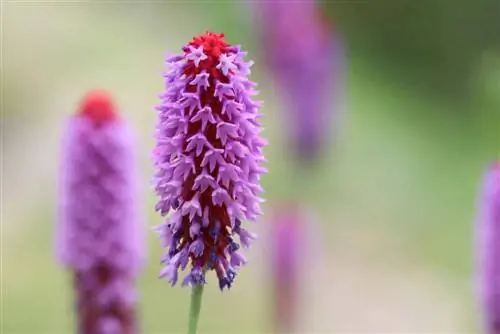
Primula vialii can be propagated well with seeds harvested by the hobby gardener himself. As soon as these have been stored in a dry place and have sprung up after about two weeks, they can be sown. To do this, proceed as follows:
- prepare small boxes with growing soil
- The seeds are put in here
- Place the boxes in a shady place and keep them moist
- In the spring, the small plants formed in this way can be planted at their location in the garden
- However, when you sow your own seeds, they usually only bloom in the second year of planting
Care errors, diseases or pests
It is a big mistake if the perennials are not watered regularly during warm and dry periods. The orchid primrose does not easily tolerate even a short period of drought and it can die. Unfortunately, snails often make life difficult for this beautiful and graceful plant. Precisely because it prefers moist areas where many snails live, it is often attacked by them and the leaves have unsightly eating spots. Therefore, take preventive measures against the annoying reptiles if possible. If they have already been infected it helps:
- Snail death from the trade
- collecting by hand
Problems:
- Does not tolerate lime
- Especially on hot days, high humidity is necessary to lower the temperature, so it's best to be at the edge of the water
- Shouldn't be too harassed by other plants, especially woody plants
- Reacts to drought by dropping flowers
- Is also popular with snails
Special features:
- Also called Chinese primrose
- Considered one of the most beautiful garden primroses
- Unfortunately, it is still very unknown as a summer-flowering primrose. However, it is highly valued by the few who know it and often forms the basis for a passion for collecting
- Fits well in the rock garden
- In suitable locations it can regenerate itself again and again from its own rootstock for many years. Soil that is too dry or warm prevents this, which is why it is often described as not enduring
Conclusion
This hardy perennial is the ideal plant for bordering a garden pond or in a rock garden. Once planted, it doesn't require much. There is no need to cut or prepare the plant for winter. The Primula vialii only needs water and a little fertilizer so that it can raise its blooming flower stalks, which are reminiscent of orchids, into the air in the summer between May and July. This makes the orchid primrose the ideal plant for all hobby gardeners who cannot or do not want to invest a lot of time. Anyone who still thinks primroses are old-fashioned has not yet discovered Primula vialii.

